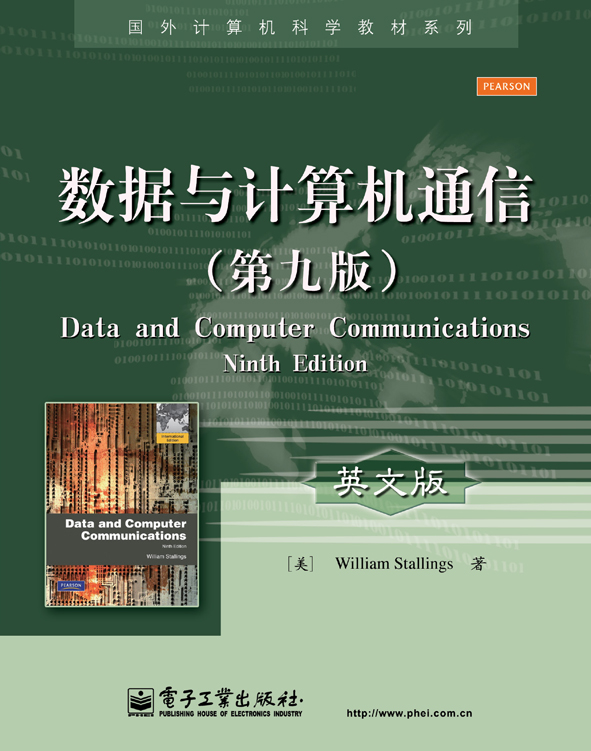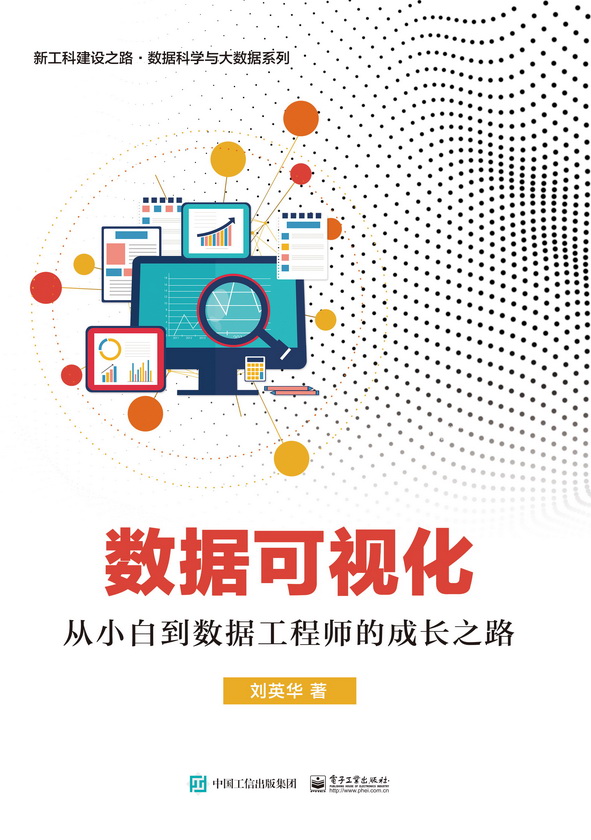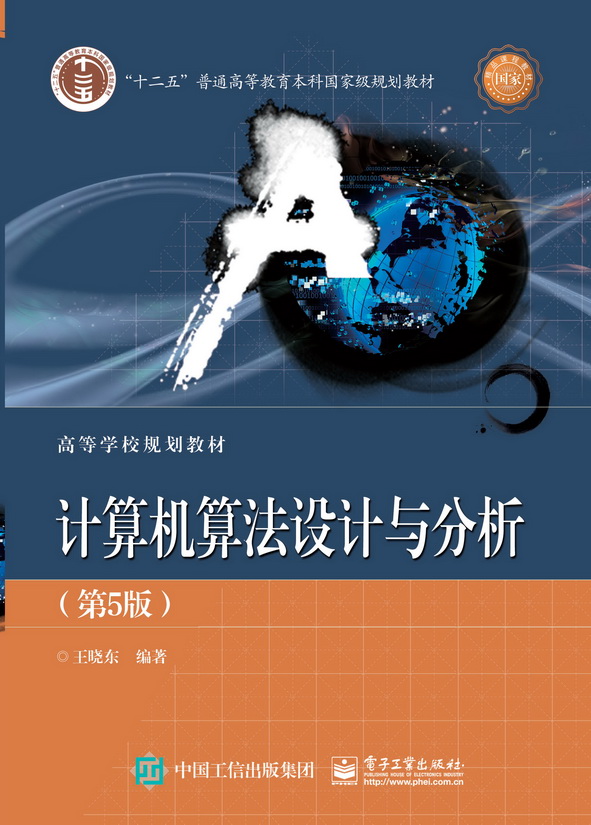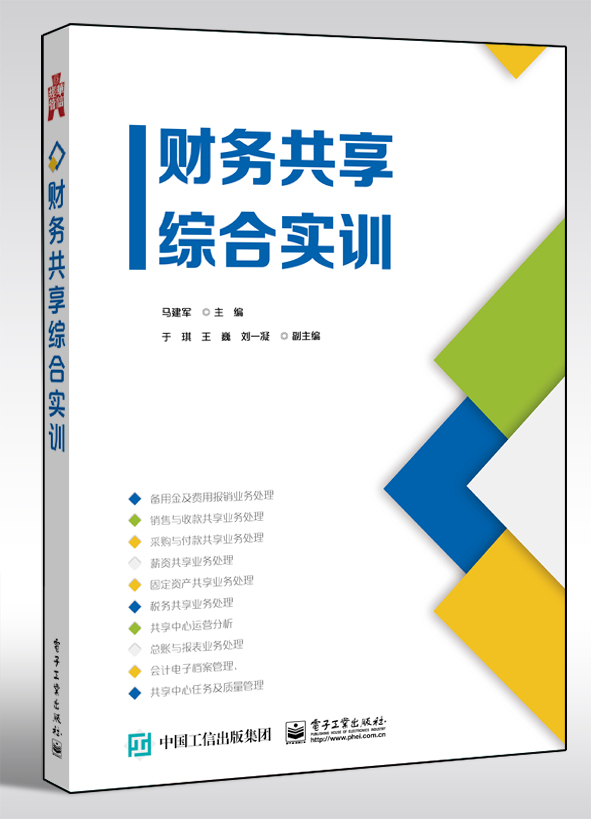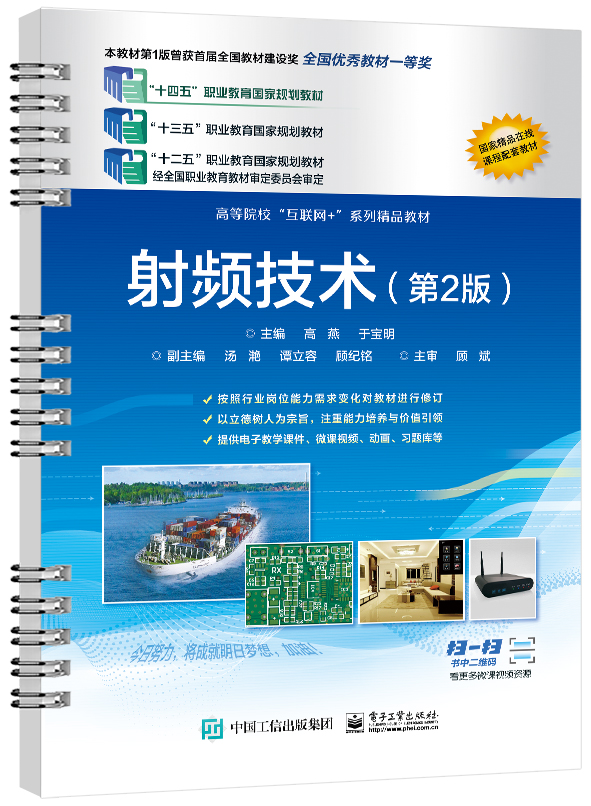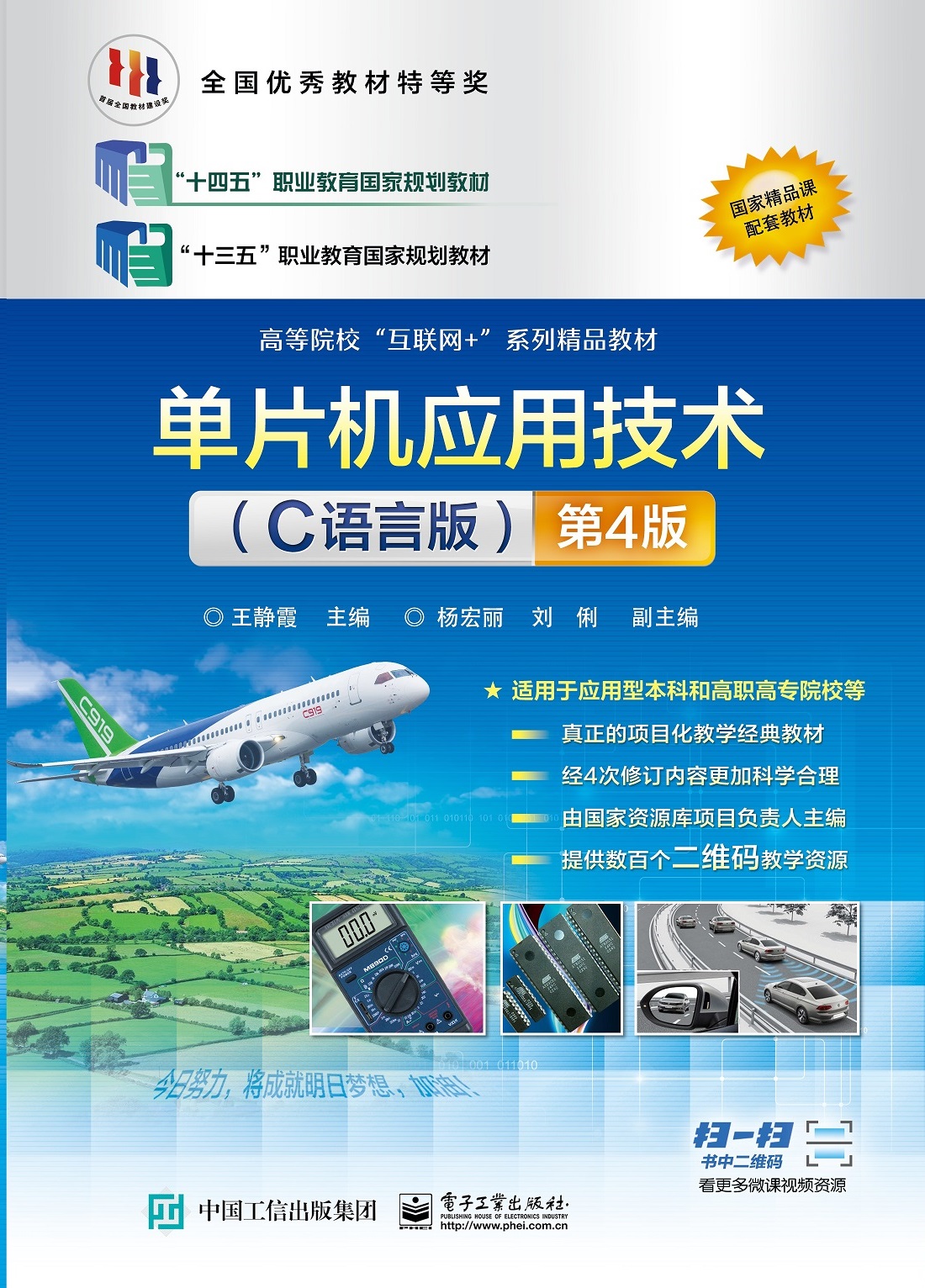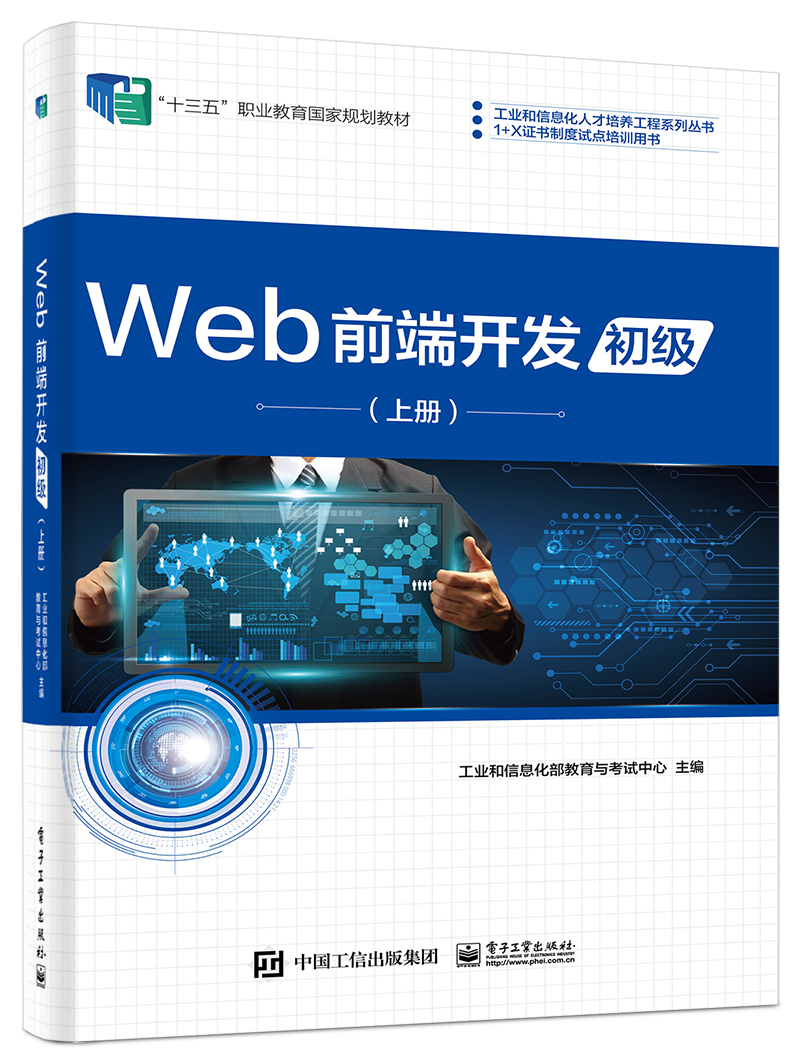数据与计算机通信(第九版)(英文版)
丛 书 名:
国外计算机科学教材系列
作 译 者:威廉 . 斯托林斯
出 版 日 期:2014-05-01
书 代 号:G0229530
I S B N:9787121229534
图书简介:
本书向授课教师提供英文原版教辅(习题解答,PPT,项目手册),具体申请方式请咨询te_service@phei.com.cn。本书是著名计算机专业作家William Stallings的经典著作之一,内容涉及基本的数据通信原理、各种类型的计算机网络以及多种网络协议和应用,覆盖面广,信息量大。这一版对上一版内容做了许多改进,使新版对通信领域各专题的阐述更清晰、更紧凑。同时,新版补充了双绞线传输标准、宽带因特网接入、第四代移动无线网络、虚拟局域网、移动IP等内容,修订了高速以太网、无线局域网、MPLS的相关内容,彻底重写了安全相关章节。此外,本书还包括术语表、参考文献、缩写词对照表。每章都附有习题和推荐读物,以便读者进一步阅读。
定价 89.0
您的专属联系人更多

联系人:陈波
电话:18973680789
邮箱:chenbo@phei.com.cn
-
配 套 资 源图书特别说明:由于成本考虑,本书不作为参考书赠送。如果确有授课教材选用的需求,可将详细情况发送给本书专属联系人,我们将进一步沟通并酌情处理。
本书资源
本书暂无资源会员上传本书资源
-
图 书 内 容
内容简介
本书向授课教师提供英文原版教辅(习题解答,PPT,项目手册),具体申请方式请咨询te_service@phei.com.cn。本书是著名计算机专业作家William Stallings的经典著作之一,内容涉及基本的数据通信原理、各种类型的计算机网络以及多种网络协议和应用,覆盖面广,信息量大。这一版对上一版内容做了许多改进,使新版对通信领域各专题的阐述更清晰、更紧凑。同时,新版补充了双绞线传输标准、宽带因特网接入、第四代移动无线网络、虚拟局域网、移动IP等内容,修订了高速以太网、无线局域网、MPLS的相关内容,彻底重写了安全相关章节。此外,本书还包括术语表、参考文献、缩写词对照表。每章都附有习题和推荐读物,以便读者进一步阅读。图书详情
ISBN:9787121229534开 本:16开页 数:804字 数:1463本书目录
CONTENTS Chapter 0 Reader’s and Instructor’s Guide 1 0.1 Outline of the Book 2 0.2 A Roadmap for Readers and Instructors 3 0.3 Internet and Web Resources 5 0.4 Standards 6 PART ONE OVERVIEW 8 Chapter 1 Data Communications, Data Networks, and the Internet 8 1.1 Data Communications and Networking for Today’s Enterprise 9 1.2 A Communications Model 16 1.3 Data Communications 19 1.4 Networks 22 1.5 The Internet 25 1.6 An Example Configuration 30 Chapter 2 Protocol Architecture, TCP/IP, and Internet-Based Applications 32 2.1 The Need for a Protocol Architecture 33 2.2 A Simple Protocol Architecture 34 2.3 The TCP/IP Protocol Architecture 38 2.4 Standardization within a Protocol Architecture 46 2.5 Traditional Internet-Based Applications 49 2.6 Multimedia 50 2.7 Recommended Reading and Web Sites 53 2.8 Key Terms, Review Questions, and Problems 54 Appendix 2A The Trivial File Transfer Protocol 57 PART TWO DATA COMMUNICATIONS 62 Chapter 3 Data Transmission 62 3.1 Concepts and Terminology 64 3.2 Analog and Digital Data Transmission 75 3.3 Transmission Impairments 83 3.4 Channel Capacity 89 3.5 Recommended Reading and Web Site 93 3.6 Key Terms, Review Questions, and Problems 94 Appendix 3A Decibels and Signal Strength 97 Chapter 4 Transmission Media 100 4.1 Guided Transmission Media 102 4.2 Wireless Transmission 116 4.3 Wireless Propagation 124 4.4 Line-of-Sight Transmission 129 4.5 Recommended Reading and Web Sites 133 4.6 Key Terms, Review Questions, and Problems 134 Chapter 5 Signal Encoding Techniques 138 5.1 Digital Data, Digital Signals 141 5.2 Digital Data, Analog Signals 151 5.3 Analog Data, Digital Signals 162 5.4 Analog Data, Analog Signals 168 5.5 Recommended Reading 175 5.6 Key Terms, Review Questions, and Problems 175 Chapter 6 Digital Data Communication Techniques 180 6.1 Asynchronous and Synchronous Transmission 182 6.2 Types of Errors 186 6.3 Error Detection 186 6.4 Error Correction 196 6.5 Line Configurations 202 6.6 Recommended Reading 203 6.7 Key Terms, Review Questions, and Problems 204 Chapter 7 Data Link Control Protocols 208 7.1 Flow Control 210 7.2 Error Control 217 7.3 High-Level Data Link Control (HDLC) 223 7.4 Recommended Reading 230 7.5 Key Terms, Review Questions, and Problems 230 Appendix 7A Performance Issues 233 Chapter 8 Multiplexing 268 8.1 Frequency Division Multiplexing 243 8.2 Synchronous Time Division Multiplexing 249 8.3 Statistical Time Division Multiplexing 259 8.4 Asymmetric Digital Subscriber Line 266 8.5 xDSL 298 8.6 Recommended Reading and Web Sites 272 8.7 Key Terms, Review Questions, and Problems 273 Chapter 9 Spread Spectrum 276 9.1 The Concept of Spread Spectrum 278 9.2 Frequency-Hopping Spread Spectrum 279 9.3 Direct Sequence Spread Spectrum 284 9.4 Code Division Multiple Access 290 9.5 Recommended Reading and Web Site 294 9.6 Key Terms, Review Questions, and Problems 294 PART THREE WIDE AREA NETWORKS 298 Chapter 10 Circuit Switching and Packet Switching 298 10.1 Switched Communications Networks 300 10.2 Circuit-Switching Networks 302 10.3 Circuit-Switching Concepts 305 10.4 Softswitch Architecture 309 10.5 Packet-Switching Principles 310 10.6 Recommended Reading 320 10.7 Key Terms, Review Questions, and Problems 320 Chapter 11 Asynchronous Transfer Mode 323 11.1 The Role of ATM 325 11.2 Protocol Architecture 326 11.3 ATM Logical Connections 328 11.4 ATM Cells 333 11.5 Transmission of ATM Cells 339 11.6 ATM Service Categories 343 11.7 Recommended Reading and Web Sites 346 11.8 Key Terms, Review Questions, and Problems 347 Chapter 12 Routing in Switched Data Networks 350 12.1 Routing in Packet-Switching Networks 351 12.2 Examples: Routing in ARPANET 361 12.3 Least-Cost Algorithms 367 12.4 Recommended Reading 372 12.5 Key Terms, Review Questions, and Problems 373 Chapter 13 Congestion Control in Data Networks 377 13.1 Effects of Congestion 379 13.2 Congestion Control 384 13.3 Traffic Management 386 13.4 Congestion Control in Packet-Switching Networks 388 13.5 ATM Traffic Management 388 13.6 ATM–GFR Traffic Management 400 13.7 Recommended Reading 403 13.8 Key Terms, Review Questions, and Problems 404 Chapter 14 Cellular Wireless Networks 407 14.1 Principles of Cellular Networks 408 14.2 First-Generation Analog 422 14.3 Second-Generation CDMA 423 14.4 Third-Generation Systems 429 14.5 Fourth-Generation Systems 433 14.6 Recommended Reading and Web Sites 438 14.7 Key Terms, Review Questions, and Problems 439 PART FOUR LOCAL AREA NETWORKS 442 Chapter 15 Local Area Network Overview 442 15.1 Topologies and Transmission Media 443 15.2 LAN Protocol Architecture 449 15.3 Bridges 457 15.4 Hubs and Switches 465 15.5 Virtual LANs 469 15.6 Recommended Reading and Web Sites 474 15.7 Key Terms, Review Questions, and Problems 474 Chapter 16 Ethernet 477 16.1 Traditional Ethernet 479 16.2 High-Speed Ethernet 489 16.3 IEEE 802.1Q VLAN Standard 498 16.4 Recommended Reading and Web Sites 500 16.5 Key Terms, Review Questions, and Problems 500 Appendix 16A Digital Signal Encoding for LANs 503 Appendix 16B Scrambling 510 Chapter 17 Wireless LANs 513 17.1 Overview 514 17.2 Wireless LAN Technology 519 17.3 IEEE 802.11 Architecture and Services 521 17.4 IEEE 802.11 Medium Access Control 526 17.5 IEEE 802.11 Physical Layer 533 17.6 Recommended Reading and Web Sites 541 17.7 Key Terms, Review Questions, and Problems 542 PART FIVE INTERNET AND TRANSPORT PROTOCOLS 545 Chapter 18 Internet Protocols 545 18.1 Principles of Internetworking 546 18.2 Internet Protocol Operation 551 18.3 Internet Protocol 558 18.4 IPv6 568 18.5 Virtual Private Networks and IP Security 577 18.6 Recommended Reading and Web Sites 580 18.7 Key Terms, Review Questions, and Problems 581 Chapter 19 Internetwork Operation 585 19.1 Multicasting 586 19.2 Routing Protocols 596 19.3 Mobile IP 607 19.4 Recommended Reading and Web Sites 619 19.5 Key Terms, Review Questions, and Problems 620 Chapter 20 Internetwork Quality of Service 623 20.1 Integrated Services Architecture 625 20.2 Resource Reservation Protocol 634 20.3 Differentiated Services 644 20.4 Service Level Agreements 652 20.5 IP Performance Metrics 654 20.6 Recommended Reading and Web Sites 657 20.7 Key Terms, Review Questions, and Problems 659 Chapter 21 Multiprotocol Label Switching 661 21.1 The Role of MPLS 663 21.2 Backgrounds 665 21.3 MPLS Operation 667 21.4 Labels 672 21.5 FECs, LSPs, and Labels 676 21.6 Label Distribution 678 21.7 Traffic Engineering 682 21.8 Virtual Private Networks 687 21.9 Recommended Reading and Web Sites 689 21.10 Key Terms, Review Questions, and Problems 690 Chapter 22 Transport Protocols 692 22.1 Connection-Oriented Transport Protocol Mechanisms 694 22.2 TCP 712 22.3 TCP Congestion Control 720 22.4 UDP 731 22.5 Recommended Reading and Web Sites 732 22.6 Key Terms, Review Questions, and Problems 733 APPENDICES 737 Appendix A Fourier Analysis 737 A.1 Fourier Series Representation of Periodic Signals 738 A.2 Fourier Transform Representation of Aperiodic Signals 739 A.3 Recommended Reading 742 Appendix B Projects and Other Student Exercises for Teaching Data and Computer Communications 743 B.1 Animations and Animation Projects 744 B.2 Practical Exercises 745 B.3 Sockets Projects 745 B.4 Wireshark Projects 746 B.5 Simulation and Modeling Projects 746 B.6 Performance Modeling 747 B.7 Research Projects 747 B.8 Reading/Report Assignments 748 B.9 Writing Assignments 748 B.10 Discussion Topics 748 References 749 Index 762 PART SIX NETWORK SECURITY(第23章和第24章的文件可登录华信教育资源网(www.hxedu.com.cn)注册下载) Chapter 23 Computer and Network Security Threats 23.1 Computer Security Concepts 23.2 Threats, Attacks, and Assets 23.3 Intruders 23.4 Malicious Software Overview 23.5 Viruses, Worms, and Bots 23.6 Recommended Reading and Web Sites 23.7 Key Terms, Review Questions, and Problems Chapter 24 Computer and Network Security Techniques 24.1 Virtual Private Networks and IPsec 24.2 SSL and TLS 24.3 Wi-Fi Protected Access 24.4 Intrusion Detection 24.5 Firewalls 24.6 Malware Defense 24.7 Recommended Reading and Web sites 24.8 Key Terms, Review Questions, and Problems ONLINE CHAPTERS PART SEVEN INTERNET APPLICATIONS 25-1 Chapter 25 Electronic Mail, DNS, and HTTP 25-1 25.1 Electronic Mail: SMTP and MIME 25-2 25.2 Internet Directory Service: DNS 25-17 25.3 Web Access and HTTP 25-28 25.4 Recommended Reading and Web Sites 25-40 25.5 Key Terms, Review Questions, and Problems 25-41 Chapter 26 Internet Multimedia Support 26-1 26.1 Real-Time Traffic 26-2 26.2 Voice Over IP and Multimedia Support— SIP 26-5 26.3 Real-Time Transport Protocol 26-15 26.4 Recommended Reading and Web Sites 26-25 26.5 Key Terms, Review Questions, and Problems 26-26 ONLINE APPENDICES Appendix C Standards Organizations C.1 The Importance of Standards C.2 Standards-Setting Organizations Appendix D The OSI Model D.1 The Model D.2 The OSI Layers Appendix E The International Reference Alphabet Appendix F Proof of the Sampling Theorem Appendix G Physical-Layer Interfacing G.1 V.24/EIA-232-F G.2 ISDN Physical Interface Appendix H Queuing Effects H.1 Queuing Models H.2 Queuing Results Appendix I ATM Adaptation Layer I.1 AAL Services I.2 AAL Protocols Appendix J Leaky Bucket Algorithms J.1 Peak Cell Rate Algorithm J.2 Sustainable Cell Rate Algorithm Appendix K The Spanning Tree Algorithm Appendix L LAN Performance Issues L.1 The Effect of Propagation Delay and Transmission Rate L.2 Simple Performance Model for CSMA/CD Appendix M Fibre Channel M.1 Fibre Channel Elements M.2 Fibre Channel Protocol Architecture M.3 Fibre Channel Physical Media and Topologies Appendix N Orthogonality, Correlation, and Autocorrelation N.1 Correlation and Autocorrelation N.2 Orthogonal Codes Appendix O TCP/IP Example Appendix P The TCP/IP Checksum P.1 Ones Complement Addition P.2 Use in TCP and IP Appendix Q Cryptographic Algorithms Q.1 Symmetric Encryption Q.2 Public-Key Cryptography Q.3 Secure Hash Functions Appendix R Uniform Resource Locators (URLs) and Uniform Resource Identifiers (URIs) R.1 Uniform Resource Locator R.2 Uniform Resource Identifier R.3 To Learn More Appendix S Augmented Backus-Naur Form Appendix T Sockets: A Programmer’s Introduction T.1 Sockets, Socket Descriptors, Ports, and Connections T.2 The Client/Server Model of Communication T.3 Sockets Elements T.4 Stream and Datagram Sockets T.5 Run-Time Program Control T.6 Remote Execution of a Windows Console Application Appendix U Frame Relay U.1 X.25 U.2 Frame Relay U.3 Frame Relay Congestion Control U.4 Problems Appendix V Derivations of Equations and Examples Glossary展开前 言
PREFACE Begin at the beginning and go on till you come to the end; then stop —Alice in Wonderland, Lewis Carroll OBJECTIVES This book attempts to provide a unified overview of the broad field of data and computer communications. The organization of the book reflects an attempt to break this massive subject into comprehensible parts and to build, piece by piece, a survey of the state of the art. The book emphasizes basic principles and topics of fundamental importance concerning the technology and architecture of this field and provides a detailed discussion of leading-edge topics. The following basic themes serve to unify the discussion: 􀁋● Principles: Although the scope of this book is broad, there are a number of basic principles that appear repeatedly as themes and that unify this field. Examples are multiplexing, flow control, and error control. The book highlights these principles and contrasts their application in specific areas of technology. 􀁋● Design approaches: The book examines alternative approaches to meeting specific communication requirements. 􀁋● Standards: Standards have come to assume an increasingly important, indeed dominant, role in this field. An understanding of the current status and future direction of technology requires a comprehensive discussion of the related standards. INTENDED AUDIENCE The book is intended for both an academic and a professional audience. For the professional interested in this field, the book serves as a basic reference volume and is suitable for self-study. As a textbook, it can be used for a one-semester or two-semester course. It covers the material in Networking (NET), a core area in the Information Technology body of knowledge, which is part of the Draft ACM/IEEE/AIS Computing Curricula 2005. The book also covers the material in Computer Networks (CE-NWK), a core area in Computer Engineering 2004 Curriculum Guidelines from the ACM/IEEE Joint Task Force on Computing Curricula. PLAN OF THE TEXT The book is divided into seven parts, which are described in Chapter 0: 􀁋● Overview 􀁋● Data Communications 􀁋● Wide Area Networks 􀁋● Local Area Networks 􀁋● Internet and Transport Protocols 􀁋● Network Security 􀁋● Internet Applications The book includes a number of pedagogic features, including the use of animations and numerous figures and tables to clarify the discussions. Each chapter includes a list of key words, review questions, homework problems, suggestions for further reading, and recommended Web sites. The book also includes an extensive online glossary, a list of frequently used acronyms, and a reference list. In addition, a test bank is available to instructors. The chapters and parts of the book are sufficiently modular to provide a great deal of flexibility in the design of courses. See Chapter 0 for a number of detailed suggestions for both top–down and bottom–up course strategies. WHAT’S NEW IN THIS EDITION This ninth edition is seeing the light of day less than four years after the publication of the eighth edition. During that time, the pace of change in this field continues unabated. In this new edition, I try to capture these changes while maintaining a broad and comprehensive coverage of the entire field. To begin the process of revision, the eighth edition of this book was extensively reviewed by a number of professors who teach the subject. The result is that, in many places, the narrative has been clarified and tightened, and illustrations have been improved. Beyond these refinements to improve pedagogy and user-friendliness, there have been major substantive changes throughout the book. Highlights include: 􀁋● Examples: The number of examples incorporated in the book has been significantly expanded. 􀁋● Twisted-pair transmission standards: This new edition covers the 2009 ANSI/TIA 568-C standards and the recent ISO/IEC 11801 twisted-pair transmissions, which are important for gigabit-range Ethernet and other high-speed twisted-pair applications. 􀁋● Expanded coverage of broadband Internet access: The sections on cable modem and DSL broadband access have been expanded. 􀁋● New coverage of fourth-generation (4G) mobile wireless networks: Includes the key 4G technology of orthogonal frequency division multiple access (OFDMA). 􀁋● New coverage of virtual LANs: VLAN technology is covered, as well is the IEEE 802.1Q standard. 􀁋● Updated coverage of high-speed Ethernet: The new 100-Gbps standard is covered, including the multilane distribution (MLD) transmission technique, plus expanded coverage of 64B/66B encoding. 􀁋● Updated coverage of Wi-Fi/IEEE 802.11 wireless LANs: IEEE 802.11 and the related Wi-Fi specifications have continued to evolve. New coverage includes 802.11n. 􀁋● Mobile IP: New to this edition is coverage of Mobile IP, which standardizes techniques for IP addressing and routing for mobile end 􀁋● MPLS: New to this edition is full chapter devoted to Multiprotocol Label Switching, which is becoming increasingly important on the Internet and other IP-based networks, as well as in telecommunications networks. In addition, throughout the book, virtually every topic has been updated to reflect the developments in standards and technology that have occurred since the publication of the eighth edition. ONLINE DOCUMENTS FOR STUDENTS For this new edition, a tremendous amount of original supporting material has been made available online, in the following categories: 􀁋● Online chapters: To limit the size and cost of the book, Four chapters of the book are provided in PDF format. The chapters are listed in this book’s table of contents. 􀁋● Online appendices: There are numerous interesting topics that support material found in the text but whose inclusion is not warranted in the printed text. A total of 23 appendices cover these topics for the interested student. The appendices are listed in this book’s table of contents. ● Homework problems and solutions: To aid the student in understanding the material, a separate set of homework problems with solutions are available. These enable the students to test their understanding of the text. ● Key papers: Several dozen papers from the professional literature, many hard to find, are provided for further reading. ● Supporting documents: A variety of other useful documents are referenced in the text and provided online. Purchasing this textbook new grants the reader six months of access to this online material. See the access card in the front of this book for details.(此段内容针对英文原版教材。相关资料可登录华信教育资源网(www.hxedu.com.cn)注册下载(其中包括第23章和第24章的文件) INSTRUCTIONAL SUPPORT MATERIALS To support instructors, the following materials are provided(教师题解手册和其他资源(PPT等)只提供给授课教师,申请方式请参见书末的“教学支持说明”): 􀁋● Solutions Manual: Solutions to all end-of-chapter Review Questions and Problems. 􀁋● Projects Manual: Suggested project assignments for all of the project categories listed below. 􀁋● PowerPoint Slides: A set of slides covering all chapters, suitable for use in lecturing. 􀁋● PDF files: Reproductions of all figures and tables from the book. 􀁋● Test Bank: A chapter-by-chapter set of questions. All of these support materials are available at the Instructor Resource Center (IRC) for this textbook, which can be reached through the Publisher’s Web site www.pearsonhighered.com/stallingsinternational or by clicking on the button labeled “Book Info and More Instructor Resources” at this book’s Web site WilliamStallings.com/DCC/DCC9e.html. In addition, the book’s Web site supports instructors with: 􀁋● Links to Web sites for other courses being taught using this book 􀁋● Sign-up information for an Internet mailing list for instructors INTERNET SERVICES FOR INSTRUCTORS AND STUDENTS There is a Web site for this book that provides support for students and instructors. The site includes links to other relevant sites, transparency masters of figures in the book, and signup information for the book’s Internet mailing list. The Web page is at WilliamStallings.com/DCC/DCC9e.html. For more information, see Chapter 0. The Publisher’s Web site www.pearsonhighered.com/stallings provides instructors and students with direct links to the Companion Web site, Instructor Resources, Premium Content, and Web chapters. New to this edition is a set of homework problems with solutions. Students can enhance their understanding of the material by working out the solutions to these problems and then checking their answers. An Internet mailing list has been set up so that instructors using this book can exchange information, suggestions, and questions with each other and with the author. As soon as typos or other errors are discovered, an errata list for this book will be available at WilliamStallings.com. In addition, the Computer Science Student Resource site at WilliamStallings.com/StudentSupport.html provides documents, information, and useful links for computer science students and professionals. PROJECTS AND OTHER STUDENT EXERCISES For many instructors, an important component of a data communications or networking course is a project or set of projects by which the student gets hands-on experience to reinforce concepts from the text. This book provides an unparalleled degree of support for including a projects component in the course. The IRC not only includes guidance on how to assign and structure the projects but also includes a set of User’s Manuals for various project types plus specific assignments, all written especially for this book. Instructors can assign work in the following areas: 􀁋● Animation assignments: Described in the following section. 􀁋● Practical exercises: Using network commands, the student gains experience in network connectivity. 􀁋● Sockets programming projects: The book is supported by a detailed description of Sockets (Appendix T).The IRC includes a set of programming projects. Sockets programming is an “easy” topic and one that can result in very satisfying hands-on projects for students. 􀁋● Wireshark projects:Wireshark is a protocol analyzer that enables students to study the behavior of protocols. A video tutorial is provided to get students started. 􀁋● Simulation projects: The student can use the simulation package cnet to analyze network behavior. 􀁋● Performance modeling projects: Two performance modeling techniques are provided: a tools package and OPNET. 􀁋● Research projects: The IRC includes a list of suggested research projects that would involve Web and literature searches. 􀁋● Reading/report assignments: The IRC includes a list of papers that can be assigned for reading and writing a report, plus suggested assignment wording. 􀁋● Writing assignments: The IRC includes a list of writing assignments to facilitate learning the material. 􀁋● Discussion topics: These topics can be used in a classroom, chat room, or message board environment to explore certain areas in greater depth and to foster student collaboration. This diverse set of projects and other student exercises enables the instructor to use the book as one component in a rich and varied learning experience and to tailor a course plan to meet the specific needs of the instructor and students. See Appendix B for details. ACKNOWLEDGMENTS This new edition has benefited from review by a number of people, who gave generously of their time and expertise. The following people reviewed all or a large part of the manuscript: Mike Kain (Drexel University), Linda Xie (University of North Carolina), Jean-Claude Franchitti (New York University), Xiaobo Zhou (University of Colorado), James Jerkins (University of Northern Alabama), Ahmed Kamal (Iowa State), Mohammed Chouchane (Columbus State), Dr. Eslam Al Maghayreh (Yarmouk University), S. Jay Yang (Rochester Institute of Technology), John Doyle (Indiana University), Maria Villapol (University of Central Florida), Murat Yukse (University of Nevada), Anura Jayasumana (Colorado State University), and Szhi-Li Zhang (University of Minnesota). Thanks also to the many people who provided detailed technical reviews of a single chapter: Robert H Greenfield, Abhilash V R (VVDN Technologies), Glen Herrmannsfeldt, Fernando Lichtschein, John South (University of Dallas), Edmond Pitt, John Traenkenschuh (CISSPISSAP, CCSA/CCSE, Microsoft MVP), and Rick Jones (Hewlett-Packard Company). Loa Andersson and Elisa Bellagamba, both of Ericsson, provided reviews of the MPLS chapter. And Valerie Maguire of The Seimon Company reviewed the material on ANSI/TIA-568. In addition, Larry Owens of California State University and Katia Obraczka of the University of Southern California provided some homework problems. Nikhil Bhargava (IIT Delhi) contributed to the set of online homework problems and solutions. Thanks also to the following contributors. Zornitza Prodanoff of the University of North Florida prepared the appendix on Sockets programming. Larry Tan of the University of Stirling in Scotland developed the animation assignments. Michael Harris of Indiana University initially developed the Wireshark exercises and user’s guide. Dave Bremer, a principal lecturer at Otago Polytechnic in New Zealand, updated the material for the most recent Wireshark release; he also developed an online video tutorial for using Wireshark. Kim McLaughlin produced the PowerPoint lecture slides. Finally, I would like to thank the many people responsible for the publication of the book, all of whom did their usual excellent job. This includes the staff at Prentice Hall, particularly my editor Tracy Dunkelberger, her assistants Melinda Haggerty and Allison Michael. Also, Jake Warde of Warde Publishers managed the reviews. With all this assistance, little remains for which I can take full credit. However, I am proud to say that, with no help whatsoever, I selected all of the quotations.展开作者简介
本书暂无作者简介 -
样 章 试 读本书暂无样章试读!
-
图 书 评 价 我要评论

